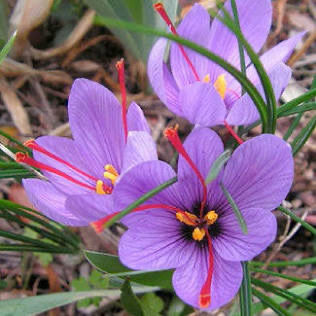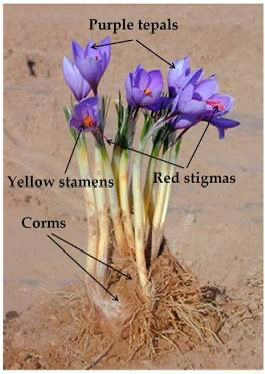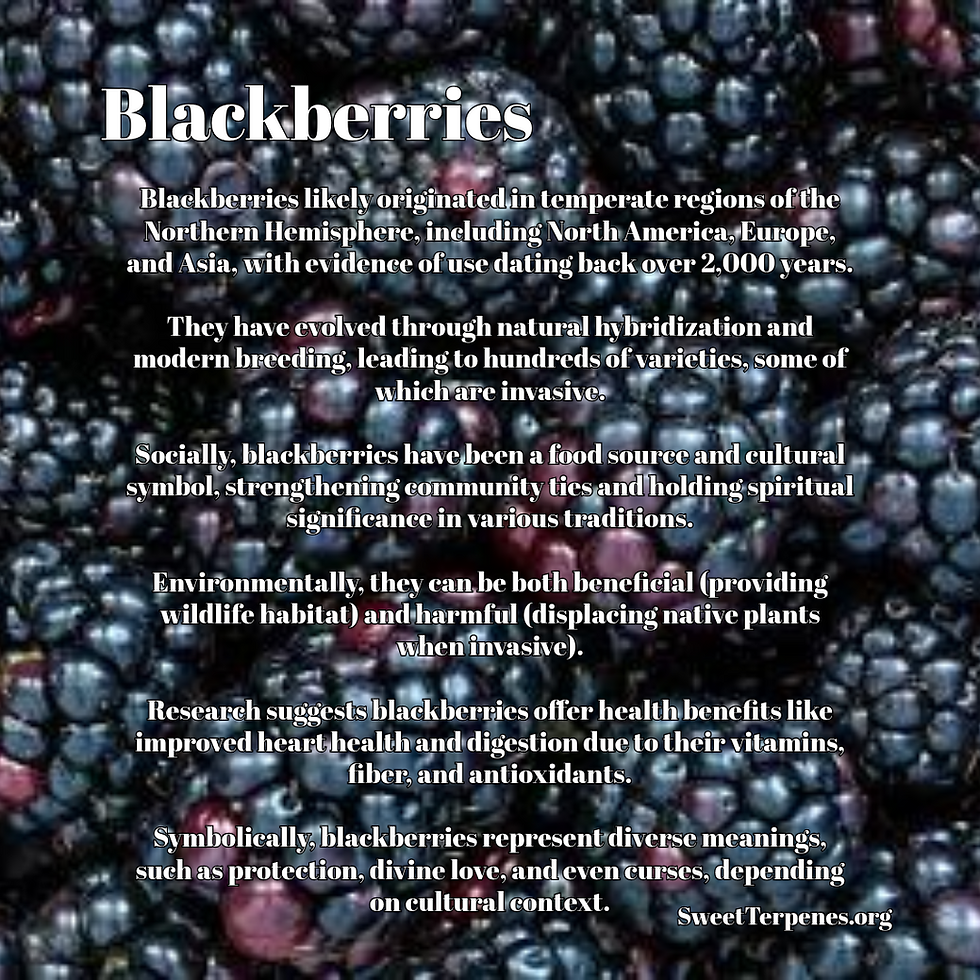Saffron: Field to Plate
- Heather Marie Stanley

- Aug 2
- 5 min read

Saffron: Field to Plate
Origin and History
The origin of saffron is a topic of debate, with evidence suggesting it likely emerged in regions such as Iran, Greece, Mesopotamia, or Kashmir. The evidence leans toward domestication in or near Greece during the Bronze Age, with its wild precursor, Crocus cartwrightianus (also known as “wild saffron”), native to mainland Greece, Euboea, Crete, Skyros, and some Cyclades islands.
Historical records indicate saffron has been cultivated and traded for over 3,500 years, with mentions in a 7th-century BC Assyrian botanical treatise and findings of saffron-based pigments in 50,000-year-old depictions in northwest Iran.
Ancient civilizations, including the Sumerians, Persians, and Minoans, utilized saffron in remedies, potions, and frescoes, highlighting its early significance. By the 10th century BC, ancient Persians cultivated it in regions like Derbent, Isfahan, and Khorasan, while Alexander the Great used it in infusions, rice, and baths, underscoring its widespread use.
Evolution
Saffron is a sterile triploid (3n) plant, incapable of seed production, and is propagated vegetatively via corm division, originating from mother corms. This sterility has shaped its evolution, making it entirely dependent on human intervention for cultivation. It has been slowly propagated throughout Eurasia, later reaching North Africa, North America, and Oceania.
The plant’s adaptability to various ecological and climatic conditions, from cold winters (−15 °C to −20 °C) to hot summers (35–45 °C), has facilitated its spread. Wild species like Crocus ancyrensis, C. cartwrightianus, C. longiflorus, and C. thomasii have been historically used in regions such as Turkey, the Cyclades, Sicily, and South Italy for saffron-related purposes, though not all ancient depictions are confirmed as modern C. sativus.

Social Impact
Saffron has played a significant role in social and cultural contexts for over 3,000 years, symbolizing wealth, power, and flavor. Its high market value, driven by labor-intensive harvesting (requiring 110,000–170,000 flowers for 1 kg), has supported rural economies, particularly in regions like Iran, which produces 76% of the global supply as of 2025. The cultivation and trade involve diverse social groups, including gardeners, farmers, travelers, and merchants, maintaining its survival through human handling.
Saffron’s cultural significance is evident in religious practices, such as its use in ancient Greek ceremonies for healing, burned as incense for divine favor, and in Hindu traditions where it represents purity and spirituality, used in paintings and rituals.
In Persian weddings, saffron water is sprinkled to symbolize joy and happiness, while European folklore associates it with protection against evil, used in sachets or charms. Its role in dyeing fabrics for nobility and religious figures, such as the saffron-yellow tunics worn by monarchs and the Dalai Lama, further embeds it in social practices.

Environmental Impact
Saffron is considered an undemanding plant, thriving in Mediterranean climates with cold winters and warm, dry summers. It tolerates a wide range of temperatures, from −15 °C to −20 °C in winter and 35–45 °C in summer, and can grow in arid or semi-arid areas with extreme water deficits. Its cultivation spans altitudes from sea level to nearly 2,000 meters, though it is most acclimatized to elevations between 600 and 1,200 meters, preferring hillsides, plateaux, and mountain valleys. This adaptability reduces environmental stress, as it is resistant to frost and can survive short periods of snow cover.
However, its cultivation can strain local ecosystems, particularly in water-scarce regions, due to irrigation needs in drier areas like Greece (500 mm annual rainfall) and Spain (400 mm) compared to moister regions like Kashmir (1,000–1,500 mm). The drying process must be carefully managed, as temperatures below 30 °C or above 60 °C trigger carotenoid degradation, affecting production sustainability.
Geographical origin influences its volatile content and antioxidant activity, with variations noted across Greece, Spain, Iran, and Morocco, impacting environmental management strategies.

Health Benefits
Saffron has been revered for its medicinal properties since ancient times, containing various plant compounds such as crocin, crocetin, safranal, picrocrocin, and kaempferol, which act as antioxidants, protecting cells against free radicals and oxidative stress. A detailed breakdown of its health benefits, supported by recent research, is presented in the following table:
Health Benefit Details
Supporting Evidence/Notes
Antioxidant Properties
Contains antioxidants like crocin, crocetin, safranal, picrocrocin, kaempferol; protects cells against free radicals and oxidative stress
Crocin, responsible for red color, may have antidepressant properties, protects brain cells
Anticancer Benefits
May selectively kill cancer cells or suppress tumor growth, applies to several cancer types; crocin may enhance chemotherapy sensitivity
2020 review found promising effects, more research needed
Depression Treatment
Significantly more effective than placebos for mild to moderate depression, as effective as fluoxetine, imipramine, citalopram; fewer side effects
2019 review, longer studies needed for recommendation
PMS Symptom Relief
May positively affect female reproductive system, provide relief from PMS symptoms
2024 review, consult healthcare professional before use
Aphrodisiac Properties
Improves libido, erectile function, overall satisfaction, especially in those on antidepressants; 30 mg daily for 4 weeks reduced sex-related pain, increased desire and lubrication in females
2019 review, 2018 review of 6 studies, 2012 study
Weight Management
Reduces appetite, BMI, waist circumference, weight; 60 mg/day for 12 weeks improved HDL cholesterol, lowered triglycerides; 8 weeks saffron extract reduced appetite, BMI, waist, fat mass
2023 study, 2017 study
Heart Disease Risk Reduction
May lower LDL cholesterol, total cholesterol, triglycerides, blood pressure, prevent vessel/artery clogging
Research indicates potential benefits
Blood Sugar Levels
May lower blood sugar, raise insulin sensitivity
2017 animal study
Improved Eyesight (AMD)
May improve eyesight in adults with age-related macular degeneration, protect against free radical damage
Research suggests benefits
Memory Improvement (Alzheimer’s)
Antioxidant properties may improve cognition in adults with Alzheimer’s disease
Research indicates potential benefits
Brain Health
May reduce risk of depression, Alzheimer’s, Parkinson’s, PTSD, epilepsy, among others
Research suggests potential benefits
Saffron is safe in standard cooking amounts, with up to 1.5 g/day as a supplement considered safe, but high doses (5 g or more) may be toxic, and pregnant individuals should avoid high doses due to potential miscarriage risks. It is advisable to purchase from reputable brands to avoid adulteration and consult a healthcare professional before using supplements.

Symbology
Saffron holds deep symbolic meaning across cultures, associated with healing, purity, prosperity, light, and knowledge. In ancient Greece, it was used in religious ceremonies to invoke divine favor, while in Hindu traditions, it symbolizes spiritual purity, often used in rituals and religious art. Its golden-yellow hue has made it a symbol of nobility and wealth, used to dye fabrics for royalty and religious figures, such as the saffron-yellow tunics worn by monarchs and the Dalai Lama.
In Persian culture, saffron is used in weddings to symbolize joy and happiness, with saffron water sprinkled during ceremonies. European folklore associates it with protection against evil, used in sachets or charms. Its role as a luxury item and its use in culinary and textile arts further reinforce its status as a symbol of richness and cultural heritage, integral to traditions along historic trade routes like the Silk Road, where it was transported from Iran and Kashmir to Europe.
This comprehensive analysis, based on data from authoritative sources, provides a thorough understanding of saffron’s multifaceted significance as of July 17, 2025.
Supporting URLs:











Comments